New products at Crocus
by Sarah - March 12th, 2010.Filed under: Crocus, New Products.
New lines at Crocus

Bougainvillea Sanderiana – Saturday £24.99
save £10.00 was £34.99Position: in summer move it outside where it gets lots of sun, then move it to a bright, heated conservatory in winterSoil: loam-based potting compostRate of growth: average Flowering period: July to September Flower colour: magenta-pinkHardiness: tender (needs winter protection)Magnificent clouds of magenta-pink floral bracts from July to September are the highlight of this strong-growing, evergreen climber. Great for growing inside a conservatory or in a tub on a sunny patio. While it can be moved outside during the summer months, it must be moved to a frost-free spot, such as a conservatory or temperate greenhouse in autumn.This plant is mini standard (it has a short, straight stem topped with a compact ball of foliage) and comes in a 3 litre pot. It will be aproximately 50cm tall.Garden care: Bougainvilleas are long-lived, and can last for over 50 years if given the correct care. They much prefer a heated conservatory and tend to go dormant at around 10°C, at which point they will lose all their leaves and flowers. Temperatures below this can be fatal. Once dormant, keep them on the dry side until they come back into growth. When they are growing well, feed weekly with a balanced liquid fertiliser and lightly prune to keep the plant bushy. Water moderately during the growing season, and re-pot or top-dress in spring.

Calamondin £24.99
Save £25.00 was £49.99Position: full sun, with a little shade during the hottest part of the day outside in summer, or a bright spot in an unheated conservatory in winterSoil: moist but well-drained soil. John Innes No2 compost should be used when potting upRate of growth: averageFlowering period: April to SeptemberFlower colour: whiteOther features: deliciously scented flowersHardiness: tender (needs winter protection)A lovely, vigorous plant with bright green leaves and scented waxy, white flowers from spring to summer. The blooms are followed by small, spherical fruit with thin, bright orange peel, and sour flesh with few seeds. Unlike most citrus, the Calamondin is quite hardy and very resistant to cold but will still need winter protection, so is best grown in a pot, and moved to a frost-free place in winter.In Vietnam the calamondin is a symbol of prosperity, and it is often given as a gift of good wishes on important, festive occassions.Garden care: In pots grow in soil-based compost in full sun. Feed every two weeks in the growing season with a special citrus fertiliser. Pot on or top-dress plants in late winter. Move outside after the risk of frost has passed to a sunny, sheltered patio.

Calamondin – Saturday £24.99
Save £25.00 was £49.99Position: full sun, with a little shade during the hottest part of the day outside in summer, or a bright spot in an unheated conservatory in winterSoil: moist but well-drained soil. John Innes No2 compost should be used when potting upRate of growth: averageFlowering period: April to SeptemberFlower colour: whiteOther features: deliciously scented flowersHardiness: tender (needs winter protection)A lovely, vigorous plant with bright green leaves and scented waxy, white flowers from spring to summer. The blooms are followed by small, spherical fruit with thin, bright orange peel, and sour flesh with few seeds. Unlike most citrus, the Calamondin is quite hardy and very resistant to cold but will still need winter protection, so is best grown in a pot, and moved to a frost-free place in winter.In Vietnam the calamondin is a symbol of prosperity, and it is often given as a gift of good wishes on important, festive occassions.Garden care: In pots grow in soil-based compost in full sun. Feed every two weeks in the growing season with a special citrus fertiliser. Pot on or top-dress plants in late winter. Move outside after the risk of frost has passed to a sunny, sheltered patio.
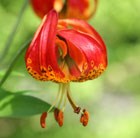
lily £8.99
Position: full sun or light shadeSoil: well-drained, including chalk, enriched with leaf mould or a loam-based potting compost such as John Innes no. 2Rate of growth: average Flowering period: JulyHardiness: fully hardyExceptionally tall and vigorous, this panther lily produces sturdy stems in midsummer carrying up to 30 nodding, turkscap flowers. The strongly reflexed tepals are crimson, fading to yellow at their base and are heavily speckled with crimson. More tolerant of alkaline soils than most.The RSPCA have recently reported that all parts of lilies can be fatal to cats, including the flower, leaves and pollen.Garden care: Lilies are best planted in autumn when the bulbs are still plump, but they can still be planted in spring. Between August and March, choose a sunny spot where the plant can keep its feet in the shade. Plant 15-20cm (6-8in) deep in a well-drained soil, enriched with well-rotted organic matter or leaf mould, using a marker to minimise any unnecessary disturbance. Stake with ring stakes or bamboo canes in spring before the flowers appear. Deadhead the faded blooms and cut the stems back to ground level at the end of autumn.
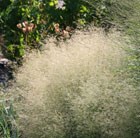
tufted hair grass (syn. Golden Dew) £6.99
Position: full sun or partial shadeSoil: dry to moist, neutral to acid soilRate of growth: average to fast-growingFlowering period: June to AugustHardiness: fully hardyA mound-forming, evergreen grass that’s particularly versatile, as itthrives in both sun and light shade and theflowers persist well into autumn. Silvery, reddish-brown flower spikes appear from early to late summer above dense mounds of slender, arching, mid-green leaves. The feathery inflorescences of this elegant, ornamental grass mature to a soft golden yellow and shimmer like agolden cloud as it catches the light. Compact and easy-to-grow, it looks gorgeous spot-planted among perennials, ingroups towards the front of a border, or in a rock gardenGarden care: Remove the faded flowerheads in late winter before new growth appears. In warm areas the plant has a tendency to self-seed freely. Where this is the case remove unwanted seedlings as part of routine border maintenance
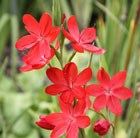
kaffir lily £6.49
Position: full sunSoil: moderately fertile, moist but well-drained soilRate of growth: fast-growing Flowering period: August and September Flower colour: deep redOther features: excellent cut flowersHardiness: hardy although flowerspikes are vulnerable to frost damageStiff, upright stems of large, deep red, gladiolus-like flowers in August and September above narrow, mid-green leaves. These eye-catching kaffir lilies provide vertical interest and a late splash of colour when many summer flowers are coming to a close. Perfect for a sheltered sunny, moist but well-drained border, they make excellent cut flowers.Garden care: Apply lots of well-rotted garden compost or manure when planting. Water during dry spells and deadhead regularly. After flowering remove the faded flowerspikes and protect the crown of the plant with a deep, dry winter mulch. Lift and divide congested plants every two or three years in spring.

Black-eyed Susan £6.49
Position: full sun or partial shadeSoil: moderately fertile, preferably heavy but well-drained soilRate of growth: average Flowering period: August to October Flower colour: orange-yellowOther features: toothed, mid-green leaves; excellent, long lasting cut-flowersHardiness: fully hardyCharming, daisy-like, orange-yellow flowers with prominent, cone-shaped, blackish-brown centres appear in abundance from August to October. This beautiful ‘black-eyed Susan’ is an excellent choice for the middle of a late summer border and it associates particularly well with ornamental grasses. It is a particularly free-flowering variety, that is best planted in bold drifts in a sunny or partially shady site that doesn’t dry out over summer.Garden care: Lift and divide congested colonies in autumn or spring. Support with ring stakes or brushwood well before the flowers appear.
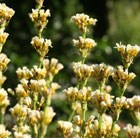
Sisyrinchium £5.99
Position: full sunSoil: poor to moderately fertile, well-drained, neutral to slightly alkaline soilRate of growth: average to fast-growing Flowering period: June to July Flower colour: pale yellowOther features: self seeds freelyHardiness: fully hardySlender spires of pale yellow flowers among clumps of iris-like, grey-green leaves. This summer-flowering perennial is perfect for a sunny herbaceous or mixed border. A good companion for grey and silver-leaved foliage plants, it performs best in well-drained, neutral to slightly alkaline soil.Garden care: Lift and divide large colonies in spring. After flowering dead-head the faded blooms to prevent the plant from self-seeding.
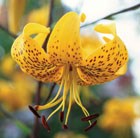
lily £4.99
Position: full sun or light shadeSoil: well-drained, including chalk, enriched with leaf mould or a loam-based potting compost such as John Innes no. 2Rate of growth: average Flowering period: JulyHardiness: fully hardyUp to 12, rich yellow, turkscap flowers, which are heavily flecked with reddish-brown, nod like glowing lanterns from each purple-stained stem in midsummer. The beautiful shape of the flowers and its strong architectural form make it an impressive sight in a mixed or herbaceous border.The RSPCA have recently reported that all parts of lilies can be fatal to cats, including the flower, leaves and pollen.Garden care: Lilies are best planted in autumn when the bulbs are still plump, but they can still be planted in spring. Between August and March, choose a sunny spot where the plant can keep its feet in the shade. Plant 15-20cm (6-8in) deep in a well-drained soil, enriched with well-rotted organic matter or leaf mould, using a marker to minimise any unnecessary disturbance. Stake with ring stakes or bamboo canes in spring before the flowers appear. Deadhead the faded blooms and cut the stems back to ground level at the end of autumn.
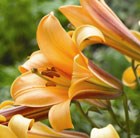
lily £4.99
Position: full sun or light shadeSoil: well-drained, including chalk, enriched with leaf mould or a loam-based potting compost such as John Innes no. 2Rate of growth: average Flowering period: JulyHardiness: fully hardyGolden yellow trumpet-shaped flowers, which have a reddish-brown flush on the reverse of each petal, appear in pyramidal racemes in midsummer. Each outward-facing or slightly pendant flower has a good scent and will grow to around 14cm long, so they really look spectacular in the border.The RSPCA have recently reported that all parts of lilies can be fatal to cats, including the flower, leaves and pollen.Garden care: Lilies are best planted in autumn when the bulbs are still plump, but they can still be planted in spring. Between August and March, choose a sunny spot where the plant can keep its feet in the shade. Plant 15-20cm (6-8in) deep in a well-drained soil, enriched with well-rotted organic matter or leaf mould, using a marker to minimise any unnecessary disturbance. Stake with ring stakes or bamboo canes in spring before the flowers appear. Deadhead the faded blooms and cut the stems back to ground level at the end of autumn.






